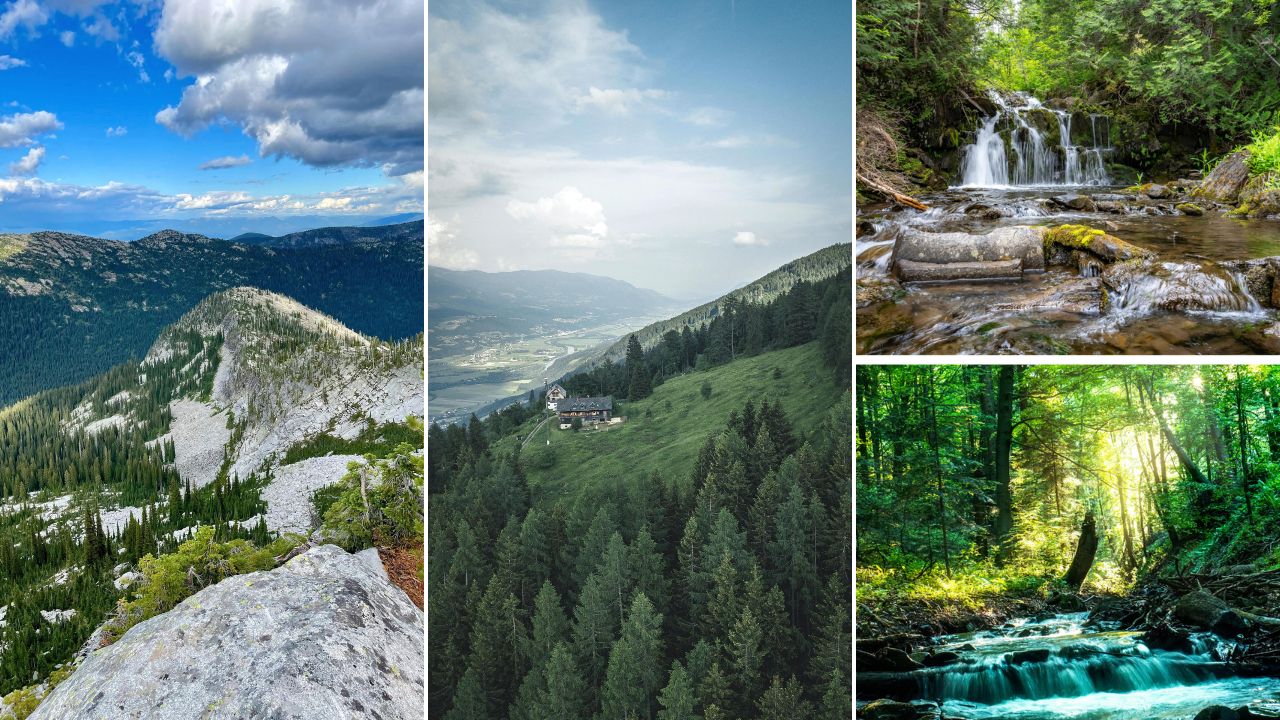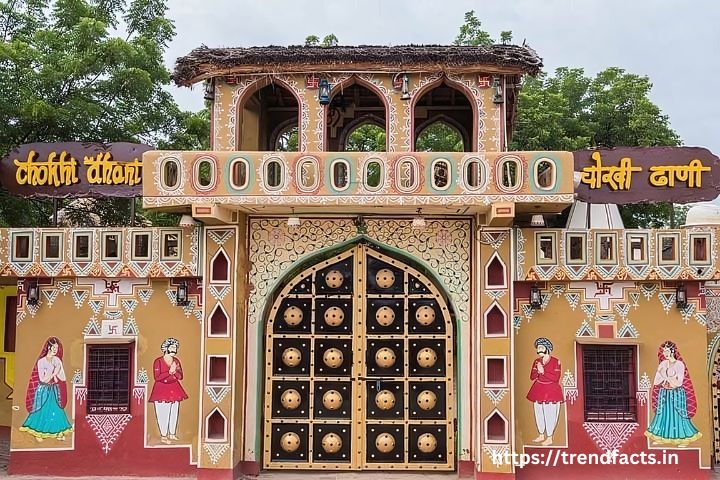
Proudly powered by WordPress
The 5 Types of Forests in India .
5 Different Forest Types of India Welcome to our blog! Get ready to embark on an exciting journey as we dive into the wonderful world of India’s forests. In this update for 2024, we’ll explore the five types of forests in India, uncovering their unique biodiversity, climate influences, and where to find them.
Every type of forest has a unique story to tell, from the untamed Alpine landscapes to the verdant Evergreen Five Different Forest Types of India. In the Indian forests, you can expect to be astounded by the rich biodiversity and breathtaking scenery that await.
There is something for every nature lover to discover in the diverse tapestry of Indian forests, whether they are searching for serene mountain retreats or vibrant, dense jungles.

India’s forests play a major role in maintaining ecological balance and encouraging biological diversity.5 Different Forest Types in India.
The nation’s environmental health depends on these verdant landscapes because they serve as a home for a wide range of flora and fauna.
We learn about the role that India’s diverse forests play in preserving life and culture as we investigate these natural wonders.
Types of forests in India and their specifications
There is an incredible natural beauty world located in the centre of India, where the Western Ghats and Northeastern regions define the landscape.
https://i.pinimg.com/474x/82/e8/8b/82e88b60c0276e22baaeb0d2f8c14437.jpg
Join us as we explore the wonders of these rainforests, with a special focus on the 5 Different Forest Types of India, the Western Ghats, and the Northeast, and discover the magic they hold within.
Tropical Rainforests of India
Set out on a journey into the heart of Earth’s most enchanting and biodiverse ecosystems
the tropical rainforests.
Often called the “lungs of the planet,” these magnificent landscapes entice travellers with their vibrant canopies, vibrant biodiversity, and a vibrant melody of life that reverberates through their dense foliage.
Western Ghats of The Tropical Rainforests of India
The exceptional biodiversity of the Western Ghats, which straddle India’s western coast, has earned them recognition as a UNESCO World Heritage Site.
5 Types of Indian Forests The fascinating Tropical Rainforests, with their thick canopies, tall trees, and diverse array of wildlife, lie tucked away among these mist-covered hills.

A vast array of plant and animal species greets us as we travel towards this protected area, all of which are vital to preserving the delicate balance of the ecosystem.
TOP 5 FORESTS IN INDIA.
- Sundarbans, West Bengal
- Pichavaram mangrove forest, Tamil Nadu
- Khasi Hills Forest, Meghalaya
- Namdapha Forest, Arunachal Pradesh
- Jim Corbett National Park, Uttarakhand
1. Sundarbans, West Bengal

WEST BENGAL FOREST
The largest and most dangerous forest in India is the Sundarbans forest, which is found in West Bengal. The top 5 forest travel destinations in India.
This fort is located on the Ganga River’s delta. The Royal Bengal Tiger is the forest’s most well-known attraction, and saltwater crocodiles are also frequently found here.
Rivers including the Padma, Meghna, Brahmaputra, Ganga, and the most revered river in India, the Sundarban delta, all meet the sea. Bangladesh and India both share the Sundarban Forest. This is the world’s greenest forest, and the terrain is very marshy.
The Sundarbans, named after the Sundari Mangrove trees, are one of the world’s largest active deltas and are located in Bangladesh and India.
Its 40,000-square-kilometre coastal mangrove forest makes it special. The forest has 102 islands, of which 54 are inhabited, and is home to over 260 species of birds as well as the magnificent striped black Royal Bengal tiger.
Best Time to Visit: September to March. Autumn comes early, and winter comes slowly. In the delta, summers are exceptionally hot.
Where to stay: Gosaba is the largest and densest island, with unique accommodations for tourists.
Things to do: boat safari in the island waterways to sight tigers and dolphins through creeks and canals; bird-watching in Sajnekhali Bird Sanctuary; a visit to Bhagabatpur Crocodile Project; a night safari to witness phytoplankton.
2. Pichavaram mangrove forest, Tamil Nadu

PICHAVARAM MANGROVE FOREST TAMIL NADU
A must-see location for travellers who enjoy the outdoors is the second-largest mangrove forest in the world.5 different Forest Types of India Pichavaram is a forest unlike any other, ideal for a peaceful weekend getaway.
Due to its function as a buffer zone for the inland areas during the 2004 tsunami, the forest’s development was regrettably impeded, despite its 200 bird species, 50 islands, 4400 canals, and 1,100-meter area.
However, this forest is a smuggler’s paradise due to its labyrinthine waterways. Most people in this area travel by boat.
However, because of its maze-like waterways, this forest is a hotspot for smugglers. Most people here get around by boat.
Surrounding the area are lush green trees and water, hosting various species of trees and plants. Many different types of forest trees are found here, making it a must-visit place for travellers. The forest will not only provide experience but also offer insightful knowledge about nature through guided tours.
Best Time to Visit: Winter is the best time to visit here for a journey, as the weather remains delightful. November to February, when the weather is pleasant. Summers are best avoided, as they are extremely hot and muggy in the area.
Things to do: Animal watching, Bird watching, Fishing, Kayaking, Boating, forest travel, etc.
Where to stay: Hotel and restaurant
3. Khasi Hills Forest, Meghalaya

MEGHALAYA FOREST
The forests located in Meghalaya are spread far and wide over a large area. The top five Khasis in India are as follows:. This forest is located at an elevation of roughly 1,978 metres in the Khasi Mountains.
The highest peak in the Khasi range is Lum Shillong, which stands at 1968 metres. It is located a few kilometres south of Shillong City.
The Khasi Mountains’ forests cover an area of roughly 2,741 square kilometres. In any case, Meghalaya is an Indian state where forests cover more than 75% of the land area.
the third largest forest in India, despite being one of the country’s five most well-known forests. It is an Indian state called Meghalaya that has a rain forest nestled among the Khasi mountains.
Because Cherrapunji is situated in the south, the jungle receives rain every day of the year. It is a lovely, verdant forest.
Best Time to Visit: The months of October through June are the ideal times to visit Meghalaya, also known as the “Abode of Clouds.” To visit the wettest place on earth, one should go there at the beginning of winter or summer and try to avoid the rainy season.
Where to Stay: La Kupar Inn, Abode of Clouds Resort, and Shillong Pine Guest House are a few of the well-liked low-cost lodging options and eateries in East Khasi Hills.
Things to do: When travelling here, tourists must not miss out on visiting the region’s most popular tourist destination, Cherrapunjee.
4. Namdapha Forest, Arunachal Pradesh

NAMDAPHA FOREST, ARUNACHAL PRADESH
Namdapha National Park is well-liked by the Indian populace. There are 5 different types of forests in India. The Namdapha Forest is the fourth largest forest in the nation, spanning 1,985 square kilometres and located in Arunachal Pradesh in the Eastern Himalayas.
These forests are located in very cold areas of India. Forest in India It is recognised for its significant biodiversity and conservation efforts. It is recognised as one of the richest regions in biodiversity in India.
Leopard mals are found in these 5 different types of forests in India and are not found anywhere else in India. Animals like red pandas, snow leopards, clouded leopards, and red foxes are found in these forests.
Best Time to Visit: The best season to visit the Namdapha Forest is from October to April, until the onset of monsoons.but almost throughout the year.
Things to do: Animals like red pandas, snow leopards, clouded leopards, and red foxes are found in these forests.
Where to stay: Restaurant and Hotel
5. Jim Corbett National Park, Uttarakhand

JIM Corben, National Park, Uttarakhand
5 different types of forests in India It is considered to be the fifth-largest forest in India. This park was established in 1936 for the endangered tiger. Jim Corbett Located in Nainital, Uttarakhand, and spread over an area of 520 square kilometres, these forests are famous for the Bengal Tiger.
In forests in India, there are numerous species of trees, but this forest has an abundance of peepal, mango, and sal trees. About 10 percent of its area is green grassland. This is a green-leaf forest.
Jim Corbett National Park is considered to be the oldest national park in India. types of forests in India Here, sunlight from the sal trees can be experienced throughout the day.
Best Time to Visit: Although one can visit Jim Corbett Park throughout the year, from November to February, due to its temperate weather, it is best to visit during the mentioned months as all the zones are open then.
Things to do: elephant safari, Jeep safari, canter safari.
Where to stay: Restaurant and Hotel
Exploring the wonders of forests can be an exhilarating experience, immersing oneself in the beauty of nature while discovering the diverse ecosystems they harbour.
Here are some pointers to maximise your forest exploration, regardless of whether you are drawn to the towering trees of Evergreen Forests, the rich biodiversity of Tropical Rainforests, the vivid foliage of Deciduous Forests, the rugged terrain of Alpine Forests, or the distinct ecosystems of Mangrove Forests:
Plan Ahead :- Before embarking on your forest adventure, research the specific type of forest you intend to explore. Understand its characteristics, climate, terrain, and any potential risks or challenges you may encounter. This preparation will help you pack appropriate gear and attire for your journey.
Equip Yourself: Ensure you have essential gear such as sturdy hiking boots, a reliable map or GPS device, a first-aid kit, plenty of water, and energy-boosting snacks. Depending on the forest type and climate, you may also need insect repellent, sunscreen, and rain gear.
Stay on Designated Trails : Respect the delicate balance of forest ecosystems by sticking to designated trails. Venturing off-trail can damage vegetation, disrupt wildlife habitats, and increase the risk of getting lost or encountering dangerous terrain.
Practice Leave-No-Trace Ethics: Minimize your impact on the environment by following Leave-No-Trace principles. Pack out all trash, avoid disturbing wildlife, and refrain from picking plants or flowers. Leave the forest as pristine as you found it for future generations to enjoy.
Take Part in Guided Tours: If you are looking for a more insightful and instructive experience, think about signing up for a guided tour run by experienced local guides. These experts can offer insights into the forest’s ecology, history, and conservation efforts, enhancing your understanding and appreciation of the natural world.
Local Guide Availability: Investigate the availability of local guides in the area you plan to explore. Numerous locations in forests provide guided tours conducted by knowledgeable naturalists or native guides who are familiar with the area and its people. Their expertise can reveal hidden gems and provide unique cultural perspectives.
Respect Local Communities: If exploring forests in areas inhabited by indigenous peoples or local communities, respect their traditions, customs, and land rights. Before visiting places of worship or taking part in any activities that might affect their way of life, get permission.
Safety First: Prioritize your safety at all times. Be aware of potential hazards, such as wildlife encounters, adverse weather conditions, and challenging terrain. Follow safety guidelines and listen to your guide’s instructions to mitigate risks and ensure a memorable, yet safe, forest exploration.
Q1: What do wet evergreen tropical forests mean, and where are they mostly found?
With dense vegetation, over 250 cm of annual rainfall, and an average temperature of 25–27 degrees Celsius, tropical wet evergreen forests flourish. Their principal distribution is on the western slopes of the Western Ghats, which includes areas like upper Assam, Arunachal Pradesh, Nagaland, Manipur, Tripura, Mizoram, and the Andaman & Nicobar Islands.
Q2: What characterises the vegetation in tropical wet evergreen forests?
Evergreen forests get their name from the trees that grow in tropical wet evergreen forests; these trees keep their leaves throughout the year. The towering, layered, and dense structure of these forests keeps sunlight from penetrating the forest floor and encourages luxuriant vegetation.
Q3: In spite of the existence of valuable species, why have tropical wet evergreen forests remained largely unaltered?
Tropical wet Evergreen forests have remained largely unexploited due to their dense undergrowth, which makes exploitation difficult despite containing valuable commercial species like mesua, cedar, bamboo, jamun, and canes.
Q4: What distinguishes tropical wet evergreen forests from tropical semi-evergreen forests?
Tropical semi-evergreen forests experience relatively drier conditions compared to tropical wet evergreen forests. They receive annual rainfall between 200 and 250 cm, have a mean temperature of 24-27 degrees Celsius, and have about 75% relative humidity.
Q5. What are the usual locations of these forests, and what prominent species are found there?
Typically, these forests can be found in the Andaman Islands, Odisha, Assam, and the lower eastern Himalayan slopes. Between moist evergreen and deciduous forests, they act as transitional zones. Among the notable species that can be found in these forests are champa, Indian chestnut, kusum, semul, and rosewood.
Q6: What are the key characteristics of tropical moist deciduous forests?
The tropical moist deciduous forests have an average annual temperature of about 27 degrees Celsius, moderate annual rainfall of 100 to 200 cm, and an average relative humidity of 60 to 75 percent.
Q7: Why are these forests valuable from a commercial standpoint, and where are they distributed?
These forests can be found in Odisha, West Bengal, the Andaman and Nicobar Islands, the Western Ghats, and the Shiwalik range. Because they produce valuable timber, they have a high commercial value. Important species include bamboo, sal, lendi, and teak.


















Comprehensive Guide to India’s 🌳🏞️🏞️Forests. This article does an excellent job of categorizing the various types of forests in India. The inclusion of specific locations and their unique characteristics makes it a must-read for nature enthusiasts. Great work.
Informative and educational. I learned so much about India’s diverse forest types from this post. The clear explanation of each forest type, along with its location and significance, is truly commendable. This is perfect for students and researchers.
A Visual and informative Treat. The detailed descriptions combined with visual representations make this article very engaging. It’s amazing how you’ve highlighted India’s ecological richness. I loved it.
Perfect Resource for Travellers. 😃😎As someone who enjoys exploring nature, this guide is incredibly helpful. Knowing where to find these forest types makes planning my trips much easier. Thank informative.
Insightful and well-researched.This article offers deep insights into the types of forests in India. I especially appreciated the focus on their geographical distribution and ecological significance. Kudos to the author!
A Nature Lover’s Delight. 🤠😎This article celebrates the diversity of India’s forests in an inspiring way. It serves as an excellent reminder of the natural treasures our country holds. Great job on this informative piece.
Engaging and Easy to Understand I loved how the content was both detailed and easy to grasp. Breaking down complex ecological information into digestible sections is no small feat. Well done.
India is fortunate to have a variety of forests! 🌱 Deciduous forests 🍂 that lose their leaves during dry seasons and tropical evergreen forests 🌧️ complete with verdant trees. Montane Forests ♰️ flourish in the hills, whereas Thorn Forests 🌵 grow in arid regions. And don’t miss the Mangrove Forests 🌊🌴 found along the coastlines! Nature’s beauty in every form! 🌏💚